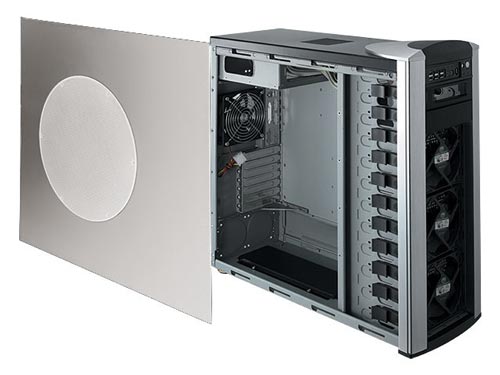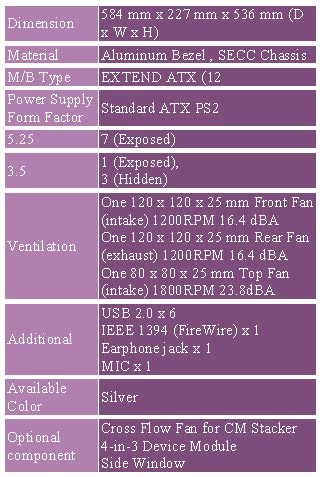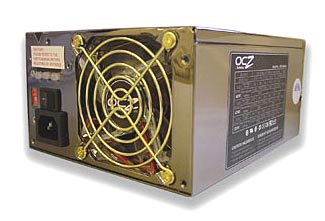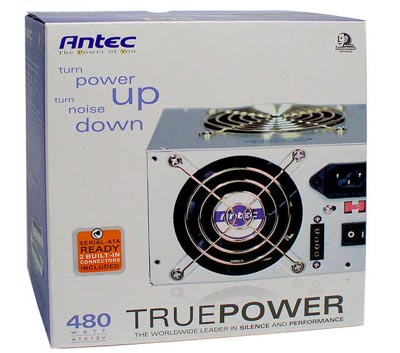Overclocking Buyer's Guide - August 2004
by Wesley Fink on July 27, 2004 11:24 AM EST- Posted in
- Guides
Case and Power Supply
Computer Case
Recommendation: Coolermaster CM Stacker (STC-T01)Price: $175 shipped
Overclockers tend to swap components at a dizzying rate, always looking for something that will run just a little faster or perform a little higher on a competitive benchmark. Since components are likely to be swapped a lot, a case should be as flexible as possible, providing for future components as well as those you might use today. Cooling is also a huge concern for overclockers, so a case that provides exceptional cooling is also a plus.

The 1.0 mm Steel Plate and Aluminum alloy Coolermaster CM Stacker is a case that fits the bill for the overclocker. Not only does it support 11 5-1/4" devices, it also supports both standard ATX and coming BTX designs. The case comes with conversion instructions for mounting a BTX motherboard. You also get support for either one or two standard ATX power supplies, and up to 8 internal fans, in addition to a unique optional crossflow fan.

Coolermaster cases are still some of the best for build-quality that you will find anywhere, and the CM Stacker is the most flexible case design that we have even seen. Whatever your particular desires in overclocking your system, you are likely to find a way to do what you need to to do with the CM Stacker.

You have to see the flexibility of the CM Stacker to believe it.
Power Supply
Recommendation: OCZ Power Stream 520WPrice: $150 shipped
The first thing that most overclockers learn is that the power supply does matter, because the first wall most overclockers run into is the inadequate power supply that came with their white-box computer. Overclocking demands much more of a computer system than running the system at stock speeds. If you think a Prescott at 3.4Ghz demands wattage, then you quickly realize a Prescott at 4.0Ghz demands even more power. The same is true of video cards. If a 6800 Ultra Extreme demands a decent 470W power supply, then you will need even more power when you overclock that 6800 Ultra to higher GPU and memory speeds.
You also quickly learn that all power supplies are not created equal. Most power supply ratings are combined ratings, as regular readers have learned in Power Supply reviews at AnandTech. This means that as some of the power supply rails are driven, other rails drop in power, and may end up supplying less than ideal power under stress. The very best power supplies individually control the power rails. They, therefore, usually handle the stress of overclocking much better than a PS with a combined rating. These are the power supplies that are most coveted by overclockers.

A superb example of a power supply geared to overclockers is the new OCZ Power Stream 520. It was designed from the ground up for overclockers, and features individual rails that are even tweakable for higher output or exact values. There are even LEDs on the rear of the black chrome case that tell you if the PS is operating in spec, under spec, or over spec. These same LEDs can even be used to tweak individual rails for optimum power.
520W sounds like a lot of power and it is, but truthfully, this power supply would probably be rated at 700 watts by a manufacturer who was trying to impress with specs. The 520W rating is conservative and this PS can easily handle almost anything an overclocker wants to throw at it. While the OCZ Power Stream are new to the market, they have quickly become favorites of the extreme overclocking community.
You will also find a stock 24-pin ATX power connector that will work with the new Socket 775 motherboards and servers, as well as a 24-pin to 20-pin adapter to use with motherboards requiring a standard 20-pin connector. There are also extra long SATA and 4-pin Molex connectors to power anything you might put in a full tower case or the CM stacker, as well as special heavy duty cables for the demands of hard drives and the latest high-end video cards. You can find out more about the Power Stream power supplies at the Power Stream product page.
Alternative: Antec True Power 480W
Price: $87 shipped
If $150 for a top power supply seems a bit rich for your budget, there is a very good alternative with the Antec True Power 480. The True Power series features individually powered rails, unlike the lesser Antec power supplies, which brings excellent stability to power-hungry overclocking.

The True Power series, in particular, is one of the most trusted power supplies among enthusiasts, and it will provide your overclocked system with stable power and some reserve for overclocking. While a good quality 350W or 400W power supply might do the job for processors and video cards at stock speeds, you will definitely need a high-quality power supply like the True Power 480 if you plan to overclock.
If you cannot find the lowest prices on the products that we've recommended on this page, it's because we don't list some of them in our RealTime pricing engine. Until we do, we suggest that you do an independent search online at the various vendors' web sites. Just pick and choose where you want to buy your products by looking for a vendor located under the "Vendor" heading.










40 Comments
View All Comments
rwinder - Tuesday, August 3, 2004 - link
I think it is a wonderful guide. Kudos for having the nads to do it, knowing that there would be "experts" that would give you crap about your recommendations. Don't let them deter you.One suggestion: Could you benchmark the performance of your recommendations (and alternatives) so us readers can make the price/value judgements?
mindless1 - Monday, August 2, 2004 - link
Seems kinda like we had to read whole article to get to the end, no?The point is, primary suggested parts were NOT appropriate for a "value o'c" system. Value does not mean merely not to choose most expensive parts in one or two areas. FOr the described value system there would be zero benefit to spending the extra $150 (over what needed spec parts would cost) on fancier case/PSU, and only a half-dozen %, at best difference in memory costing twice as much... that's not value at all, it's much higher than avg cost for new system in the market today.
lazerasa - Monday, August 2, 2004 - link
You people whining about the case, memory, and video card on the value selections... read the systems summary page, there are other, cheaper recommendations there. Read the whole artice before you start your whining.mindless1 - Monday, August 2, 2004 - link
CM Stacker is a nice case but c'mon, who's going to build a value o'c system and spend $262 on case + PSU?Likewise, someone would have to be kinda stupid to spend $300-odd $ on high end memory for the value o'c system unless /required/ by the particular 'board just to get 1GB or more stable. Other suggested systems would be a more appropriate platform for that memory.
BTW, the OCZ 520W PSU is not all that great. It IS fancy, but the base design (including after the cosmetic tweaks) cannot support 520W. Sadly it may be no better than a Sparkle 350W yet priced 3X higher. Don't be fooled by a $3 big anodized heatsink or "good" reviews where they don't subject it to a heavy load... after all that was the whole point of 520W, no? TO someone who knows PSU, it only takes a very short glance at that PSU to know why it can't support 520W.
cnq - Saturday, July 31, 2004 - link
Wesley,I agree with many of the comments: we may not agree with all your picks, but we really like the enthusiasm and obvious energy that you've poured into your picks and your writeup.
Now for a little more feedback :)
There wasn't any "value" video card pick.
Was that intentional, or an oversight? I can understand that the next gen vid cards are *so* far ahead in performance that you would urge your readers to spring for one, but still it seems that you should toss in a value pick.
So, thinking of the Athlon2500 buyer who (presumably) can't spring $400 for a next-gen vid card, what would you recommend in the $175-$199 price range? My picks would be a 9800pro followed by a 5900XT. (True, the 5900XT was born to overclock [390-->500 seems the norm ], but that doesn't mean it catches up to an overclocked 98pro in absolute performance.)
rjm55 - Saturday, July 31, 2004 - link
29 and WesleyThanks for clearing up the Athlon XP mobile info. I was a bit confused with the difference in the specs with desktop Barton, but now its clear. If you gotta have a XP, it looks like the 2600+ Mobile is now the one to get.
Wesley Fink - Friday, July 30, 2004 - link
#29 - You are correct and I actually do know better. The multipliers and FSB have been corrected in the Athlon XP section on page 6.#31, #32, and #33 - I fully understand that many look at overclocking to bring more value to their computer buying. There are also others who use overclocking to bring new performance highs to their computer platform. As I stated in the review, these 2 goals are often at odds. That is exactly the reason I have done BOTH Performance OC and Value OC recommendations and alternates.
If Value is your main OC concern, then throw all the rocks you like at my Value picks, but please don't assume the Performance OC buyers don't exist or don't matter. I can assure you from emails and discussions on Forums that Performance OC is also an important concern for many buyers who OC their systems.
WheelsCSM - Thursday, July 29, 2004 - link
I agree with Z80. While I understand that different people view value differently, I can't see how a $390 video card or $175 case can be considered value in anyone's book. Other than that, I think this was an excellent article, and I look forward to future overclocking system recommendations.Z80 - Thursday, July 29, 2004 - link
I'd say that most of your readers, like me, see overclocking as just another means to squeeze more "bang-for-the-buck" out of our PC dollars. We like to run well in the benchmarks but at the same time spend half of what a typical Dell customer might spend for the same performance. In my opinion, you missed your "Value OC" goal by a mile. If it wan't for your last statement "go with a cheaper case for $100 less. Second, buy an ATI 9800 PRO for $200 less and overclock the heck out of it. Third, go for one of the CAS 2.5 value DDR400 memories from Corsair, Geil, OCZ, Kingston, and others; this could save you about $125. These three substitutions reduce the price by $425 and get the core system price down to $836" Maybe you should look at factoring in a bang-for-your-buck cost comparison factor like you did with a recent video card review.Z80 - Thursday, July 29, 2004 - link
I'd say that most of your readers, like me, see overclocking as just another means to squeeze more "bang-for-the-buck" out of our PC dollars. We like to run well in the benchmarks but at the same time spend half of what a typical Dell customer might spend for the same performance. In my opinion, you missed your "Value OC" goal by a mile. If it wan't for your last statement "go with a cheaper case for $100 less. Second, buy an ATI 9800 PRO for $200 less and overclock the heck out of it. Third, go for one of the CAS 2.5 value DDR400 memories from Corsair, Geil, OCZ, Kingston, and others; this could save you about $125. These three substitutions reduce the price by $425 and get the core system price down to $836" Maybe you should look at factoring in a bang-for-your-buck cost comparison factor like you did with a recent video card review.